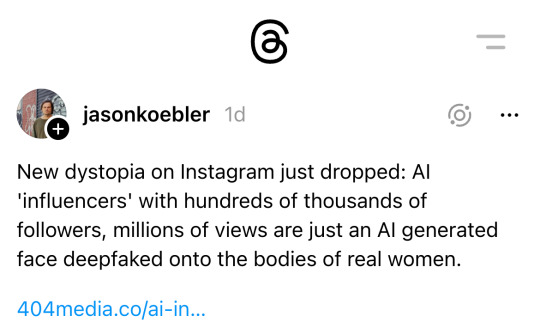#Ethics of deepfakes
Text


#ai influencers#deepfakes#social media marketing#digital ethics#inauthentic content#influencer marketing#virtual reality#computer generated imagery#dystopian fiction
35 notes
·
View notes
Text
The rise of multimodal AI: A fight against fraud
New Post has been published on https://thedigitalinsider.com/the-rise-of-multimodal-ai-a-fight-against-fraud/
The rise of multimodal AI: A fight against fraud

In the rapidly evolving world of artificial intelligence, a new frontier is emerging that promises both immense potential and significant risks – multimodal large language models (LLMs).
These advanced AI systems can process and generate different data types like text, images, audio, and video, enabling a wide range of applications from creative content generation to enhanced virtual assistants.
However, as with any transformative technology, there is a darker side that must be addressed – the potential for misuse by bad actors, including fraudsters.
One of the most concerning aspects of multimodal LLMs is their ability to generate highly realistic synthetic media, commonly known as deepfakes. These AI-generated videos, audio, or images can be virtually indistinguishable from the real thing, opening up a Pandora’s box of potential misuse.
Fraudsters could leverage deepfakes to impersonate individuals for purposes like financial fraud, identity theft, or even extortion through non-consensual intimate imagery.
Moreover, the scale and personalization capabilities of LLMs raise the specter of deepfake-powered social engineering attacks on an unprecedented level. Bad actors could potentially generate tailored multimedia content at scale, crafting highly convincing phishing scams or other fraudulent schemes designed to exploit human vulnerabilities.

Poisoning the well: Synthetic data risks
Another area of concern lies in the potential for fraudsters to inject malicious synthetic data into the training sets used to build LLM models. By carefully crafting and injecting multi-modal data (text, images, audio, etc.), bad actors could attempt to “poison” the model, causing it to learn and amplify undesirable behaviors or biases that enable downstream abuse.
This risk is particularly acute in scenarios where LLM models are deployed in critical decision-making contexts, such as financial services, healthcare, or legal domains. A compromised model could potentially make biased or erroneous decisions, leading to significant harm or enabling fraudulent activities.
Evading moderation and amplifying biases
Even without intentional “poisoning,” there is a risk that LLM models may inadvertently learn and propagate unethical biases or generate potentially abusive content that evades existing moderation filters. This is due to the inherent challenges of curating and filtering the massive, diverse datasets used to train these models.
For instance, an LLM trained on certain internet data could potentially pick up and amplify societal biases around race, gender, or other protected characteristics, leading to discriminatory outputs. Similarly, an LLM trained on unfiltered online content could conceivably generate hate speech, misinformation, or other harmful content if not properly governed.
Responsible AI: A necessity, not a choice
While the potential risks of multimodal LLMs are significant, it is crucial to recognize that these technologies also hold immense potential for positive impact across various domains. From enhancing accessibility through multimedia content generation to enabling more natural and intuitive human-machine interactions, the benefits are vast and far-reaching.
However, realizing this potential while mitigating the risks requires a proactive and steadfast commitment to responsible AI development and governance. This involves a multifaceted approach spanning various strategies.

1. Robust data vetting and curation
Implementing rigorous processes to vet the provenance, quality, and integrity of training data before feeding it into LLM models. This includes advanced techniques for detecting and filtering out synthetic or manipulated data.
2. Digital watermarking and traceability
Embedding robust digital watermarks or signatures in generated media to enable traceability and detection of synthetic content. This could aid in identifying deepfakes and holding bad actors accountable.
3. Human-AI collaboration and controlled sandboxing
Ensuring that LLM-based content generation is not a fully autonomous process but rather involves meaningful human oversight, clear guidelines, and controlled “sandboxing” environments to mitigate potential misuse.
4. Comprehensive model risk assessment
Conducting thorough risk modeling, testing, and auditing of LLM models pre-deployment to identify potential failure modes, vulnerabilities, or unintended behaviors that could enable fraud or abuse.
5. Continuous monitoring and adaptation
Implementing robust monitoring systems to continuously track the performance and outputs of deployed LLM models, enabling timely adaptation and mitigation strategies in response to emerging threats or misuse patterns.
6. Cross-stakeholder collaboration
Fostering collaboration and knowledge-sharing among AI developers, researchers, policymakers, and industry stakeholders to collectively advance best practices, governance frameworks, and technological solutions for responsible AI.
The path forward is clear – the incredible potential of multimodal LLMs must be balanced with a steadfast commitment to ethics, security, and responsible innovation. By proactively addressing the risks and implementing robust governance measures, we can harness the power of these technologies to drive progress while safeguarding against their misuse by fraudsters and bad actors.
In the eternal race between those seeking to exploit technology for nefarious ends and those working to secure and protect it, the emergence of multimodal LLMs represents a new battlefront.
It is a fight we cannot afford to lose, as the stakes – from financial security to the integrity of information itself – are simply too high. With vigilance, collaboration, and an unwavering ethical compass, we can navigate this new frontier and ensure that the immense potential of multimodal AI is a force for good, not a paradise for fraudsters.
Looking for templates you can use for your AI needs?
Whether it’s a project roadmap template or an AI ethics and governance framework, our Pro+ membership has what you need.
Plus, you’ll also get access to 100s of hours of talks by AI professionals from leading companies – and more!
Sign up today. 👇
AI Accelerator Institute Pro+ membership
Unlock the world of AI with the AI Accelerator Institute Pro Membership. Tailored for beginners, this plan offers essential learning resources, expert mentorship, and a vibrant community to help you grow your AI skills and network. Begin your path to AI mastery and innovation now.

#Accessibility#ai#AI development#AI Ethics#ai skills#AI systems#applications#approach#artificial#Artificial Intelligence#audio#autonomous#box#Collaboration#Community#Companies#compass#comprehensive#content#continuous#data#data poisoning#datasets#deepfake#deepfakes#deployment#detection#developers#development#domains
0 notes
Text

Individual prints are available at Pictorem: https://aniimaillussiya.pictorem.com
#Face#Art#Generated#DigitalArt#Portrait#DeepLearning#NeuralNetworks#MachineLearning#FaceGenerator#Portraiture#SyntheticMedia#VirtualModel#GeneratedFaces#DeepFake#GANArt#ArtificialIntelligence#FutureArt#Fashion#Ethics#FaceCreation
0 notes
Text

Are you ready to dive into a gripping tale of technology, deceit, and ancient beliefs? Discover how Phil's black ops mission uncovers a sinister plot by an AI corporation to manipulate indigenous people on a remote Asian island for strategic gain. This story, "The Counsel With Nicea: The Sinister Plot on a Remote Island," reveals the clash between #ancient worship and modern manipulation, challenging our perceptions of technological advancement.
Subscribe and read more...
As Steve Jobs once said, "Innovation distinguishes between a leader and a follower." Let's discuss how we can ensure #technology serves #humanity ethically and responsibly. Read the full story and share your thoughts!
#ai#ethics#newsletter#indigenous#innovation#deepfake#storytelling#values#artificialintelligence#spirituality
0 notes
Text
0 notes
Text
Navigating Ethical Concerns Around Using AI to Clone Voices for Political Messaging
Navigating Ethical Concerns Around Using AI to Clone Voices for Political Messaging
The use of artificial intelligence (AI) for voice cloning in political messaging is a complex and nuanced issue that raises significant ethical concerns. As technology continues to advance, it’s crucial to understand the implications and navigate these challenges responsibly.
Understanding AI Voice Cloning in…

View On WordPress
0 notes
Text
Navigating AI Security Challenges: A Comprehensive Guide
Unlocking the future: Navigating AI security challenges with #Cybersecurity #AIethics #Privacy #Deepfakes #DataSecurity
In the ever-changing realm of technology, artificial intelligence (AI) emerges as a disruptive powerhouse. Yet, amidst its alluring progress, daunting security obstacles emerge. This blog endeavors to plunge into the complexities of AI security, scrutinizing the perils, remedies, and burgeoning trends in this pivotal sphere.
AI, with its supposed learning and adaptability, is supposedly…

View On WordPress
#AI biases#AI ethics#AI regulation#AI security#AI vulnerabilities#autonomous systems#Cybersecurity#cybersecurity measures#cybersecurity threats#data privacy#deepfakes#encryption#machine learning#quantum computing#secure communication
1 note
·
View note
Text
YouTube's AI Tool for Creators to Use Famous Artists' Voices: A Potential Game-Changer

YouTube is reportedly in talks with record labels to develop an AI tool that would allow creators on the platform to use the voices of famous artists. This could have a major impact on the music industry and on the way that content is created on YouTube.
If the tool is developed, it will allow creators to create new songs, videos, and other content using the voices of their favorite artists. This could open up new creative possibilities and make it easier for creators to produce high-quality content.
However, there are also some potential concerns about the use of AI to create music. One concern is that it could lead to copyright infringement. If creators are able to use the voices of famous artists without their permission, it could violate the artists' intellectual property rights.
Another concern is that it could be used to create deepfakes, which are videos or audio recordings that have been manipulated to make it appear as if someone is saying or doing something that they never actually said or did. Deepfakes can be used for malicious purposes, such as spreading misinformation or damaging someone's reputation.

Here are some additional thoughts on the potential impact of this new tool:
It could democratize music creation. By making it easier for anyone to create music with the voices of famous artists, the tool could open up new opportunities for aspiring musicians and creators.
It could lead to new and innovative forms of music. The tool could be used to create new genres of music that would not be possible without AI. For example, creators could combine the voices of different artists to create unique and unexpected soundscapes.
It could change the way that music is consumed. The tool could make it easier for people to create their own personalized music experiences. For example, people could use the tool to create custom playlists of their favorite songs with their favorite artists singing them.

Overall, the development of this new tool is a significant event that can potentially change the music industry and how content is created on YouTube. It is important to monitor the development of the tool and to ensure that it is used in a responsible and ethical way.
#YouTube AI tool#famous artists' voices#creators#music industry#content creation#copyright infringement#deepfakes#democratize music creation#new and innovative music#personalized music experiences#music consumption#responsible and ethical use of AI#music technology#artificial intelligence#machine learning#deep learning#future of music#future of content creation#ethics of AI#copyright law#MusicTech#musiclife#productionmusic#musiccomposer#gamecomposer#musiccomposerformedia#musictech#musictechnology#musicproducer
0 notes
Text
If AI Goes Wrong, It Can Go Quite Wrong: Understanding the Risks of AI: Biases, Black Boxes, and Unintended Consequences
During a Senate committee hearing on how to regulate the rapidly developing field of AI, Sam Altman, the CEO of OpenAI, the company behind ChatGPT, expressed concern about the potential risks of artificial intelligence. He warned that AI could “cause significant harm to the world” if it is not properly regulated. Altman emphasized that although AI has numerous benefits, it can also “go quite…

View On WordPress
#AI#AI biases#AI examples#AI failures#AI risks#AI vulnerabilities#Artificial Intelligence#Bias#Black Box#black box problem#Consequences#Deepfake#Ethics#Healthcare#Regulations#Risks#Unintended Consequences
0 notes
Text

Fixed it!
0 notes
Text

🚨AI ALERT: Are We Headed Towards a Dystopian Sci-Fi Future? Unchecked Power and Fake News 💻🌐📰👥🤖
Science fiction has long warned us of the dangers of unchecked power ⚠️ and the consequences of fake news 📰. In "Dark City" 🌃 and "1984" 📚, dystopian worlds are depicted where manipulation and fabrication are used to control and oppress society 🔗.
Artificial intelligence has made incredible strides in recent years 🤖⏩, but it's important to recognize the potential pitfalls of this technology as well. As we continue to rely more and more on AI to make decisions and process information, we run the risk of losing control of the very systems we've created 🌐🔓.
One needs only look at dystopian sci-fi movies and literature like "Dark City" 🎥 and "1984" 📖 to see how fabrication and fake news can be used to control societies and experiment on humanity. In these works, powerful entities use manipulation and disinformation to shape reality and create a false sense of security for the masses 🎭🔮.
But what happens when these fictional scenarios become reality with the rise of artificial intelligence? 🤖💭🌏
AI has the power to create and spread fake news on an unprecedented scale, with the ability to manipulate our thoughts and actions without our knowledge 🧠🔄. The potential for abuse is immense, as seen with the recent surge in deepfakes and disinformation campaigns 📺👤🔍.
As AI technology continues to advance, we must be vigilant in ensuring that it is used ethically and transparently 👁️⚖️. We cannot allow a future where AI holds unchecked power and uses it to control and manipulate society 🚫🕹️. It's up to us to ensure that science fiction remains just that - fiction 📚🚀.
#dystopian#AI#science fiction#manipulation#fabrication#control#oppression#technology#pitfalls#decision making#reality shaping#fake news#society#humanity#deepfakes#disinformation campaigns#ethics#transparency#unchecked power
0 notes
Text
OpenAI’s safety oversight reset (what it means) - CyberTalk
New Post has been published on https://thedigitalinsider.com/openais-safety-oversight-reset-what-it-means-cybertalk/
OpenAI’s safety oversight reset (what it means) - CyberTalk


EXECUTIVE SUMMARY:
OpenAI is setting up a new safety oversight committee after facing criticism that safety measures were being deprioritized in favor of new and “shiny” product capabilities.
CEO Sam Altman and Chairman Bret Taylor will co-lead the safety committee, alongside four additional OpenAI technical and policy experts. Committee members also include Adam D’Angelo, the CEO of Quora, and Nicole Seligman, who previously served as general counsel for the Sony Corporation.
The committee will initially evaluate OpenAI’s existing processes and safeguards. Within 90 days, the committee is due to submit formal recommendations to OpenAI’s board, outlining proposed improvements and new security measures.
OpenAI has committed to publicly releasing the recommendations as a means of increasing accountability and public trust.
Addressing user safety
In addition to scrutinizing current practices, the committee will contend with complex challenges around aligning AI system operations with human values, mitigating potential negative societal impacts, implementing scalable oversight mechanisms and developing robust tools for AI governance.
AI ethics researchers and several of the company’s own employees have critically questioned the prioritization of commercial interests over detailed safety evaluations. The release of ChatGPT-4o has amplified these concerns, as ChatGPT-4o is significantly more capable than past iterations of the technology.
Major AI research labs (think Anthropic, DeepMind…etc) and other tech giants pursuing AI development will likely follow OpenAI’s lead by forming independent safety and ethics review boards.
AI and cyber security
The extremely fast development of versatile AI capabilities has led to concerns about the potential misuse of AI tools by those with malicious intent. Cyber criminals can leverage AI to execute cyber attacks, spread disinformation and to compromise business or personal privacy.
The cyber security risks introduced by AI are unprecedented, making solutions — like AI-powered security gateways that can dynamically inspect data streams and detect advanced threats — critically important.
Check Point Software has developed an AI-driven, cloud-delivered security gateway that leverages machine learning models to identify attempted exploitations of AI; deepfakes, data poisoning attacks and AI-generated malware, among other things. This multi-layered protection extends across networks, cloud environments, mobile devices and IoT deployments.
Protect what matters most. Learn more about Check Point’s technologies here. Lastly, to receive practical cyber insights, groundbreaking research and emerging threat analyses each week, subscribe to the CyberTalk.org newsletter.
#advanced threats#ai#AI Ethics#AI research#ai tools#AI-powered#analyses#anthropic#Artificial Intelligence#board#boards#Business#CEO#chatGPT#ChatGPT-4o#Check Point#Check Point Software#Cloud#cloud-delivered#compromise#cyber#cyber attacks#cyber criminals#cyber security#data#data poisoning#deepfakes#DeepMind#development#devices
0 notes
Text
The Pros and Cons of Generative AI
Generative AI refers to the technology that can generate new content such as text, images, music, or videos. Like any technology, it has its advantages and disadvantages. Here are some of the pros and cons of generative AI:
Pros:
Creativity: Generative AI can generate new and creative content that can be used in various fields, including music, art, and advertising. It can come up with novel…

View On WordPress
#artificial intelligence#automation#ChatGPT#deepfake videos#ethical concerns#generative ai#intellectual property#personalization
0 notes
Link
Pitfalls Of Image Generator AI And Deep Fake Technology
0 notes
Text
AI Voice Cloner: The Ultimate Guide

Artificial Intelligence (AI) has revolutionized the way we communicate with machines. The development of AI technology has brought us many useful tools that make our lives easier, including AI voice cloners. AI voice cloners allow users to replicate a person's voice using a machine learning algorithm. The applications of this technology are vast, from entertainment to education to business. In this guide, we will dive into the world of AI voice cloning, explore its benefits and limitations, and discuss its ethical implications.
What is AI Voice Cloning?
AI voice cloning, also known as voice synthesis, is a technology that uses machine learning algorithms to replicate a person's voice. The process involves training an AI model with a large amount of audio data from the target speaker. The algorithm analyzes the unique features of the speaker's voice, such as pitch, intonation, and pronunciation, and creates a synthetic voice that sounds like the target speaker.
How Does AI Voice Cloning Work?
The process of AI voice cloning can be broken down into three main steps: data collection, training, and synthesis.
Data Collection
The first step in AI voice cloning is data collection. The AI model requires a large amount of high-quality audio data from the target speaker to analyze and learn from. This data is usually collected through recordings of the target speaker's voice in various contexts and situations.
Training
Once the data is collected, it is used to train the AI model. The AI algorithm analyzes the audio data, identifies patterns and unique features of the target speaker's voice, and learns to replicate them.
Synthesis
The final step is synthesis. Once the AI model is trained, it can be used to synthesize new audio that sounds like the target speaker. The AI algorithm takes a text input and converts it into speech using the synthetic voice of the target speaker.
Applications of AI Voice Cloning
AI voice cloning has numerous applications in various industries. Here are some of the most common uses of this technology:
Entertainment
AI voice cloning is used in the entertainment industry to create digital versions of celebrities and historical figures. These digital personas can be used in movies, video games, and other media to provide a more immersive experience for the audience.
Education
AI voice cloning can be used in education to create digital tutors and language learning tools. These tools can provide personalized feedback and instruction to students, helping them improve their language skills.
Business
AI voice cloning can be used in business to create personalized customer service experiences. Companies can use AI voice clones of their employees to interact with customers, providing a more human-like experience.
Accessibility
AI voice cloning can be used to create synthetic voices for people with speech disabilities. These voices can be customized to match the user's natural voice, providing a more natural communication experience.
Limitations of AI Voice Cloning
While AI voice cloning has many benefits, it also has some limitations that must be considered. Here are some of the main limitations of this technology:
Quality
The quality of AI voice clones can vary depending on the quality of the input data and the complexity of the target speaker's voice. Some voices may be more difficult to clone accurately than others, resulting in lower quality voice clones.
Ethics
The ethical implications of AI voice cloning are a concern. The technology can be used for malicious purposes, such as creating deepfake videos or impersonating individuals for fraudulent activities.
Privacy
AI voice cloning requires a large amount of audio data from the target speaker. This raises privacy concerns, as the data could be used for other purposes without the speaker's consent.
Ethical Implications of AI Voice Cloning
Fraudulent Activities
AI voice cloning can be used for fraudulent activities such as phishing scams and social engineering attacks. Attackers can use AI voice clones to impersonate individuals, tricking victims into revealing sensitive information or completing fraudulent transactions.
Misinformation and Propaganda
AI voice cloning can also be used to create deepfake videos that spread misinformation or propaganda. These videos can be used to manipulate public opinion or discredit individuals.
Invasion of Privacy
AI voice cloning requires a significant amount of audio data from the target speaker. This data can include private conversations or sensitive information that the speaker may not want to be shared. The use of this data without the speaker's consent can be an invasion of privacy.
Conclusion
AI voice cloning is a powerful technology that has many applications in various industries. From entertainment to education to business, AI voice cloning has the potential to enhance our lives in many ways. However, the technology also has ethical implications that must be considered. As the technology continues to advance, it is essential to address these concerns to ensure that AI voice cloning is used for positive purposes.
FAQs
What is the difference between AI voice cloning and voice-over?
Voice-over is a technique used in media production where a voice actor records audio to be used in a video or audio project. AI voice cloning, on the other hand, uses machine learning algorithms to replicate a person's voice.
Is AI voice cloning legal?
The legality of AI voice cloning varies by jurisdiction. In some countries, it is legal as long as it is not used for fraudulent or malicious purposes. In other countries, it may be illegal without the target speaker's consent.
Can AI voice clones be used to create fake news?
Yes, AI voice cloning can be used to create deepfake videos that spread misinformation or propaganda.
0 notes
Text
It's not just that finding an actor who Looks Like Another Actor and a VA who Sounds Like That Actor is more ethical, it also looks and sounds better than the ghoulish deepfakes and AI voices
Like in Halloween Kills they just had a crew member who looked a lot like Donald Pleasence put on some extra prosthetics to look more like Donald Pleasence, and then had a guy who could do a Donald-Pleasence-in-Halloween voice doing the voice. They had people angrily accusing them of using CGI but it legit was just prosthetics and some look/soundalikes. There was a guy in the 80s/90s who built a whole career out of looking like Humphrey Bogart, we can find Guys Who Look Like Guys if we try
3K notes
·
View notes